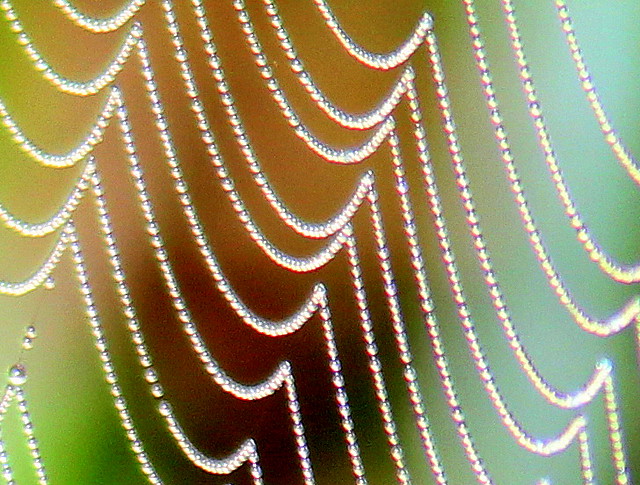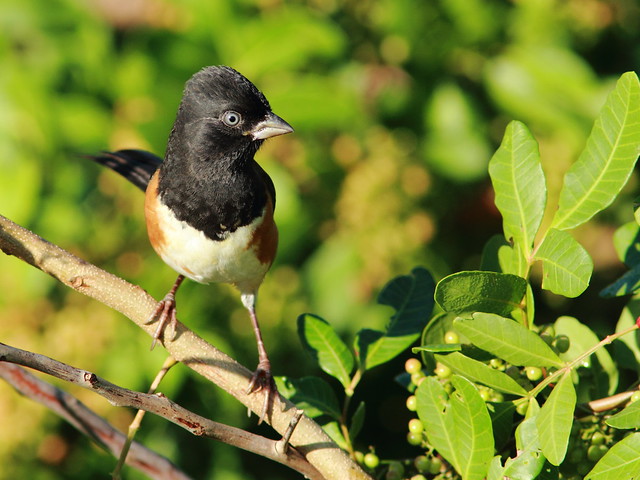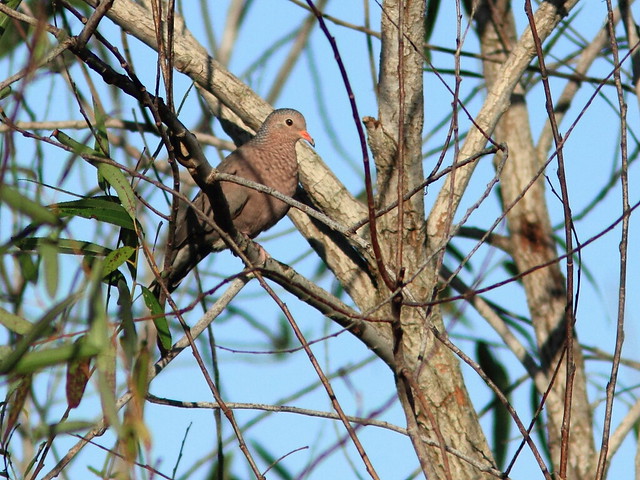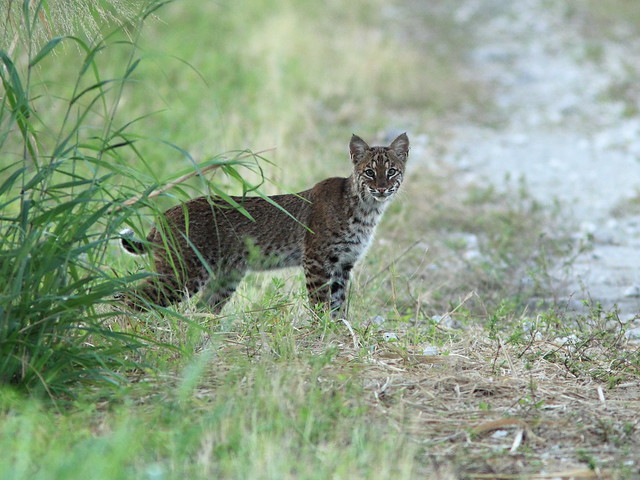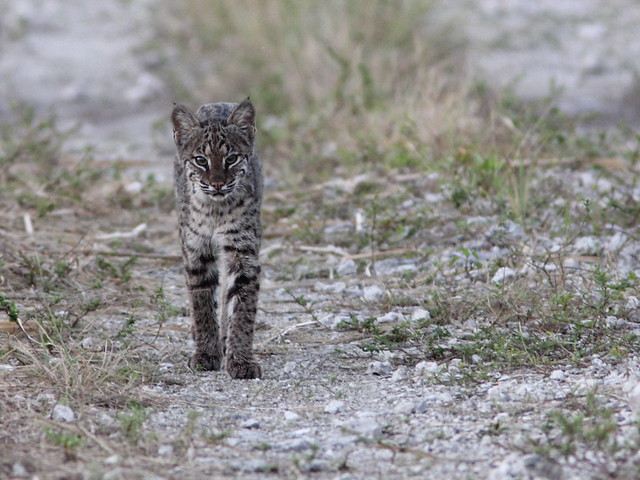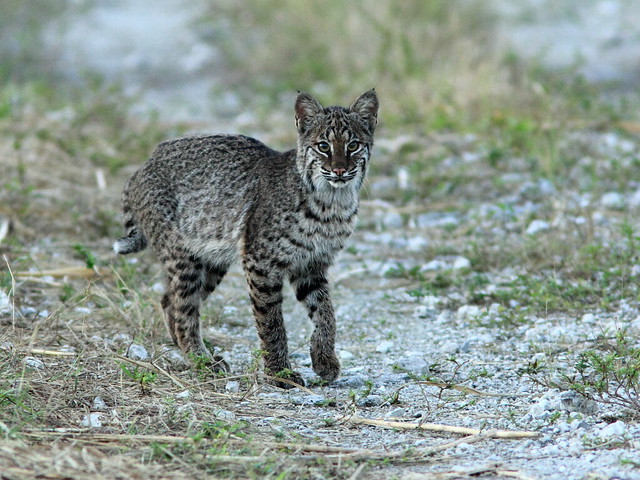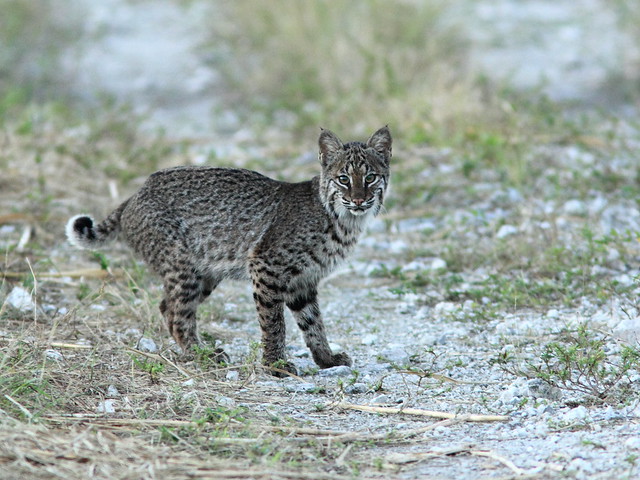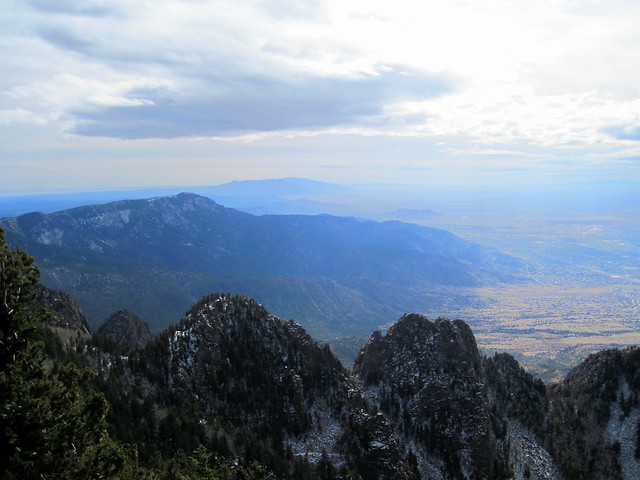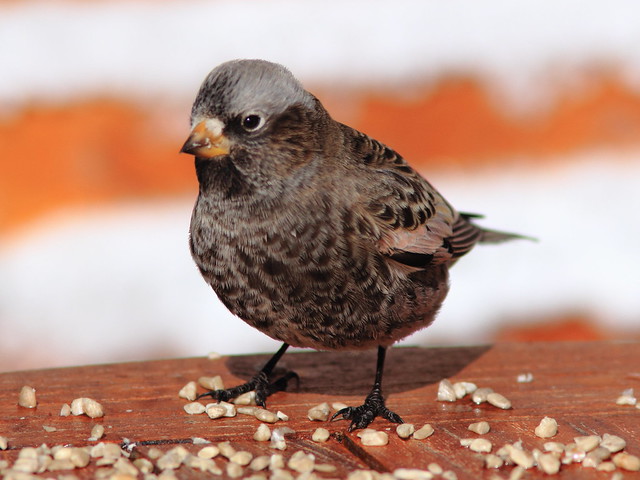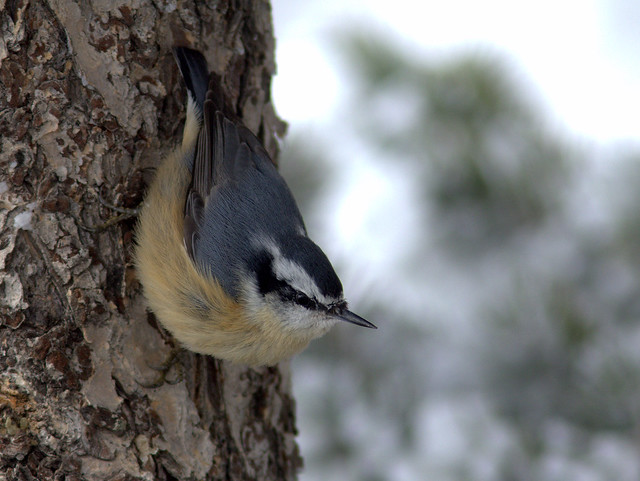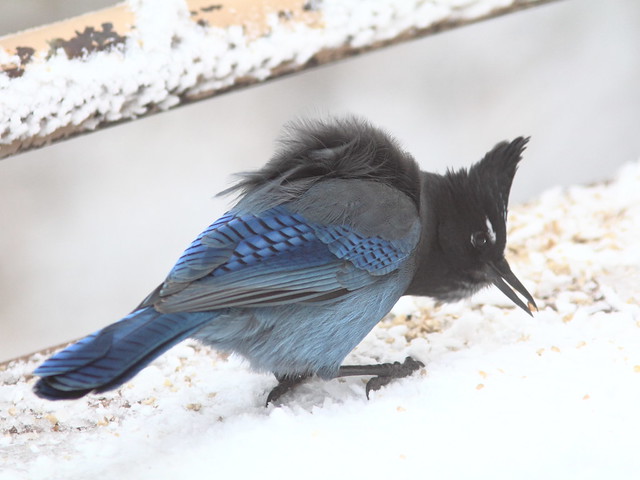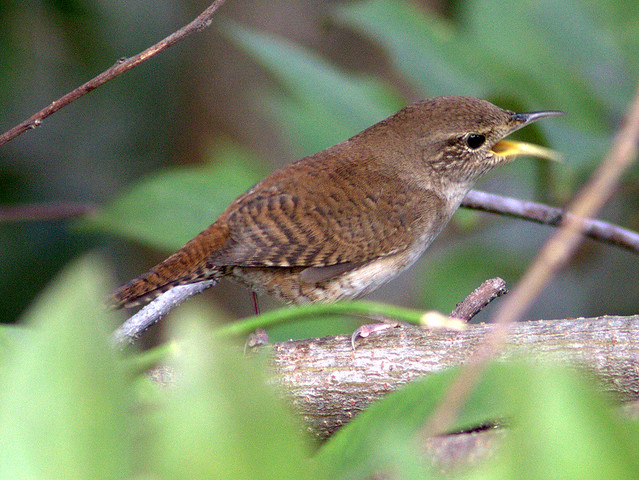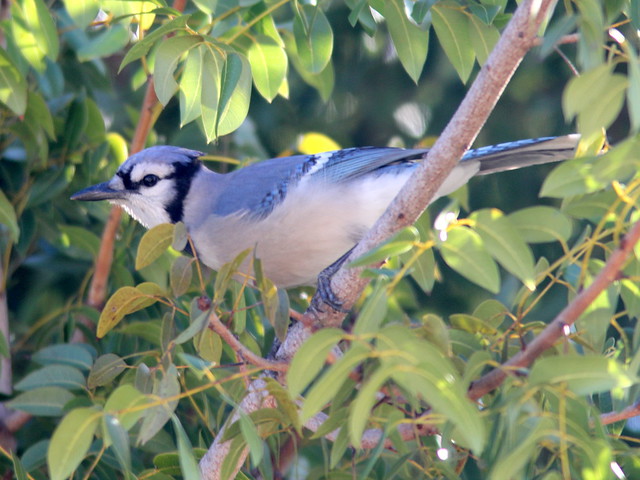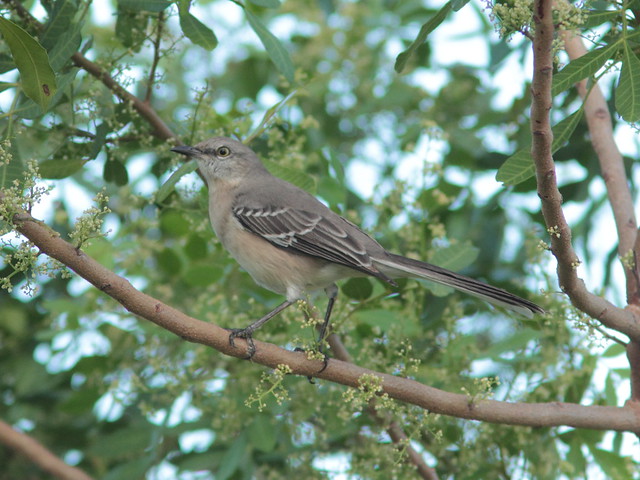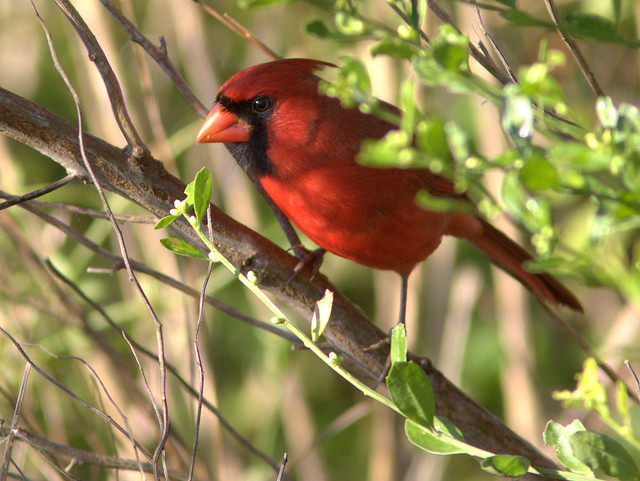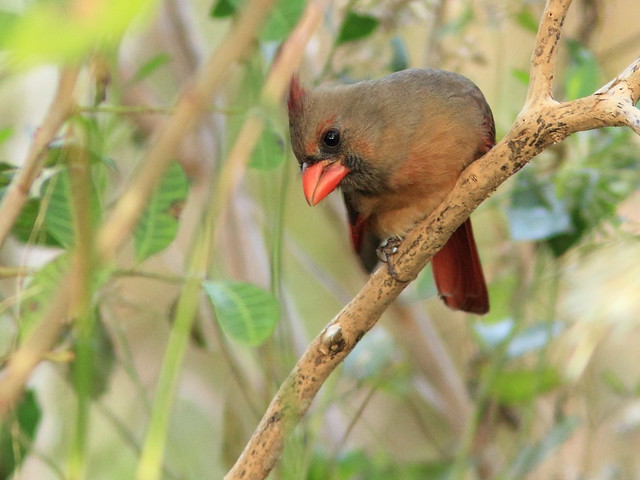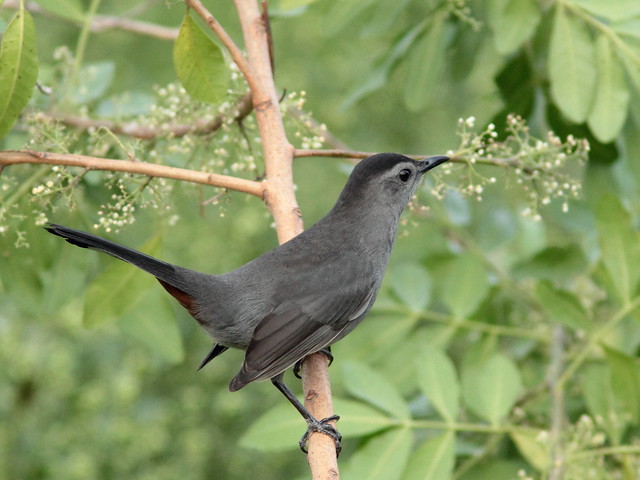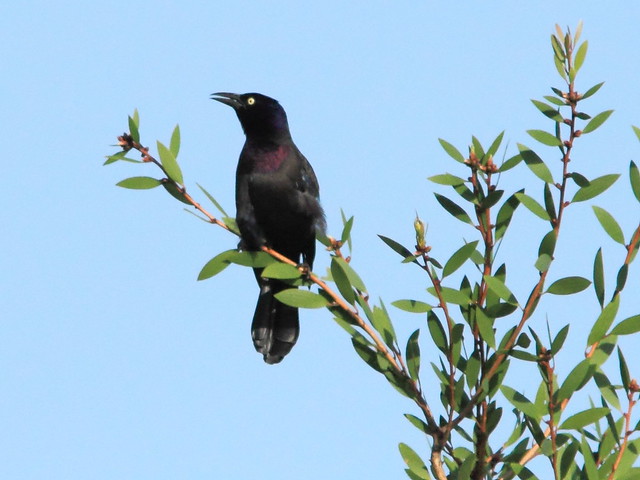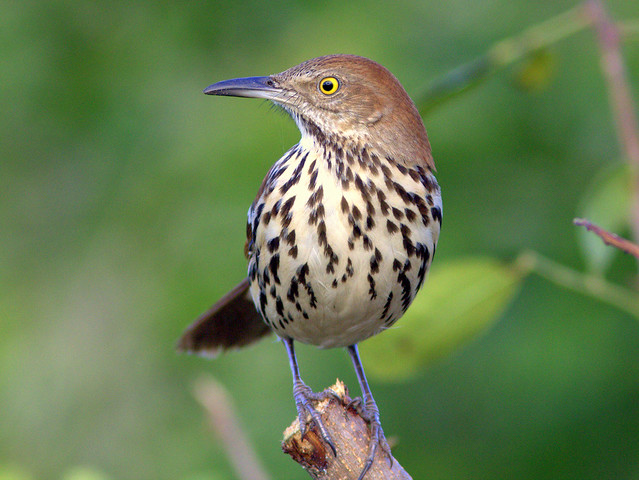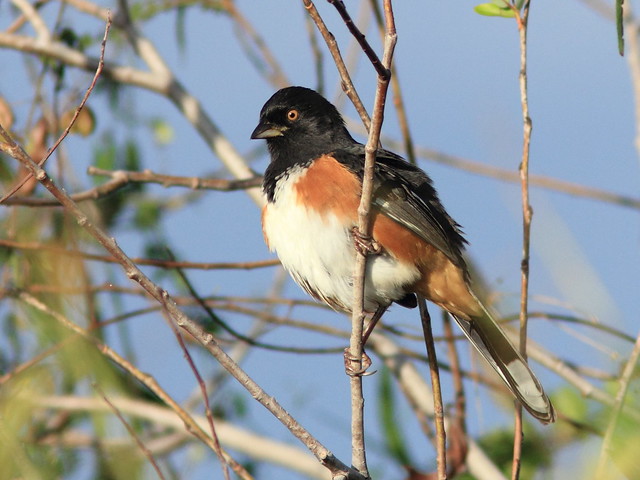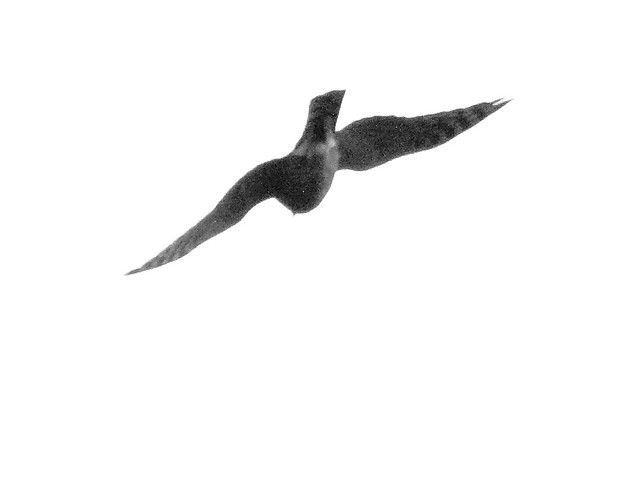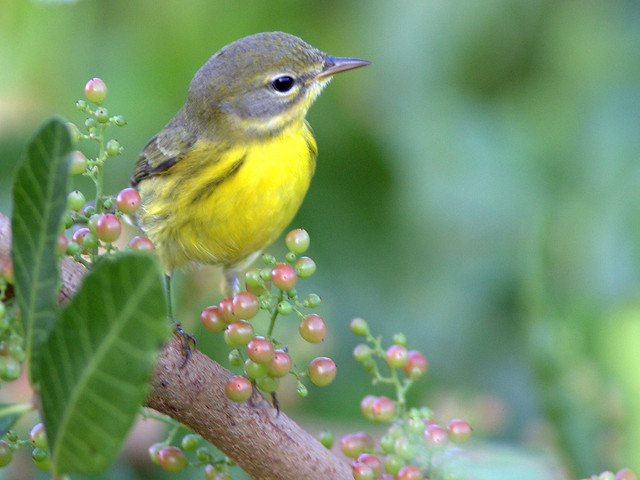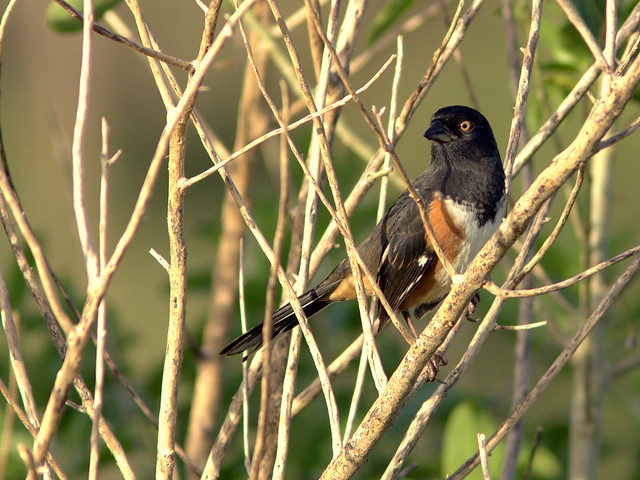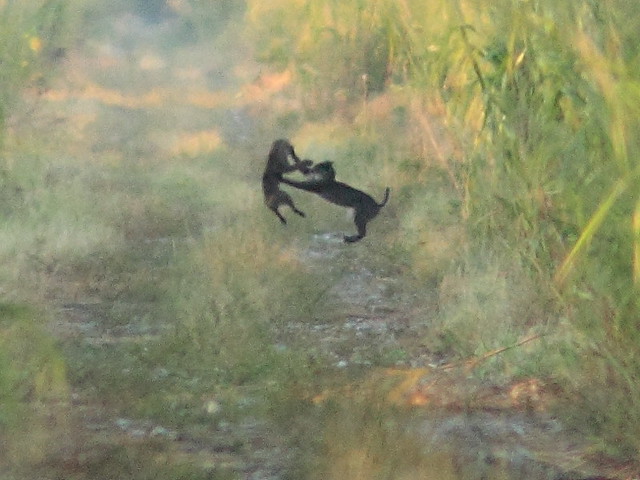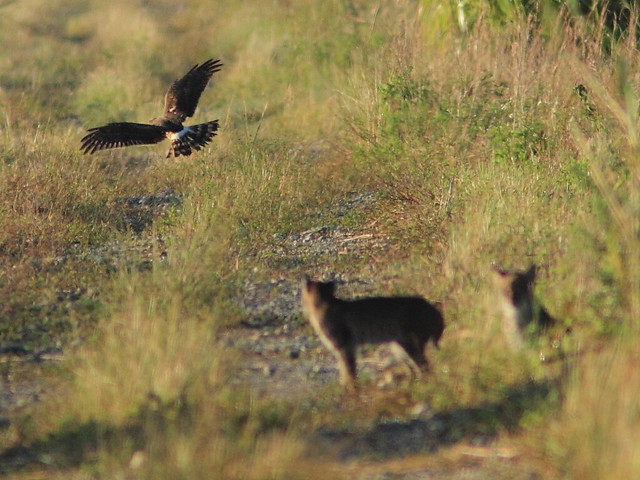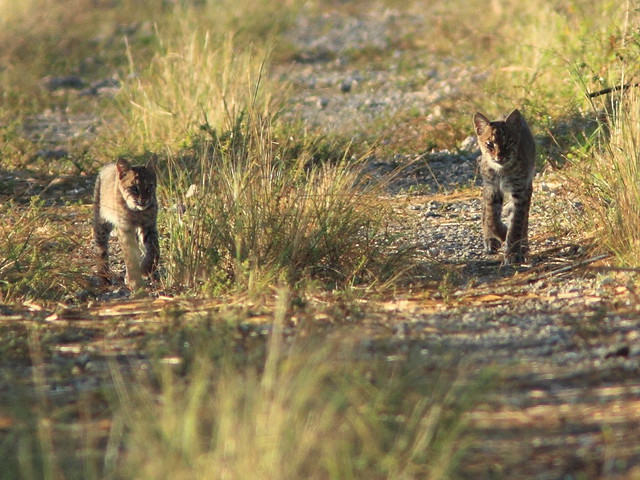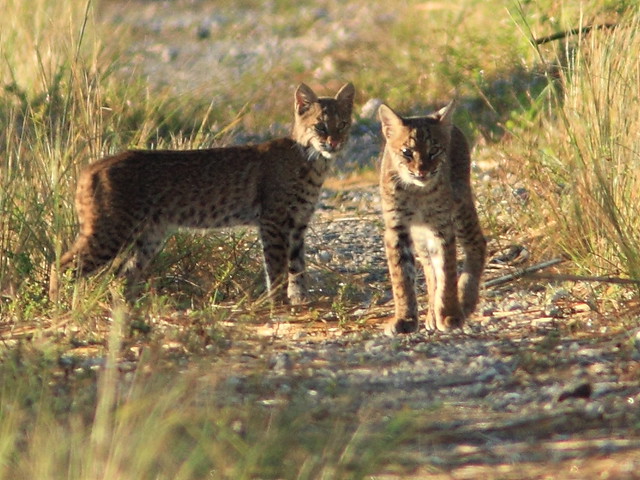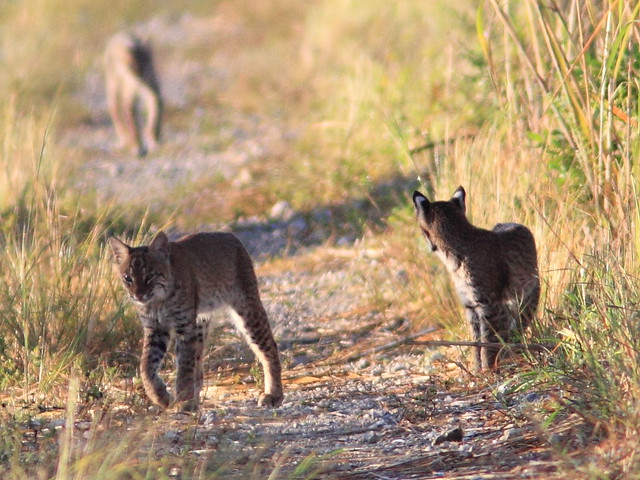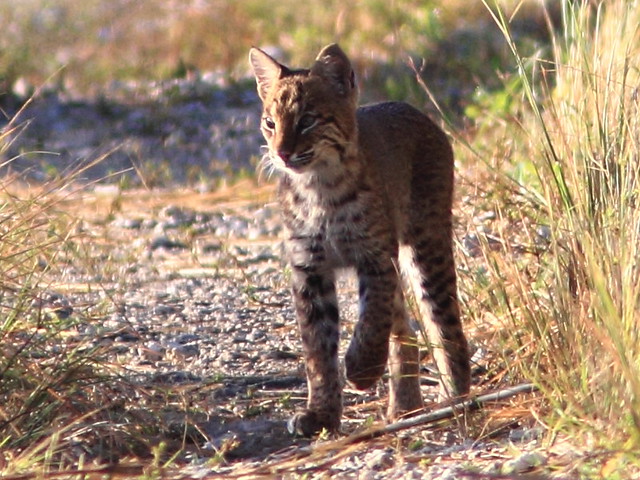Posted by: Ken @ 1:03 pm
A couple of days ago, the dew point was high and the air very still when We walked out on the wetlands adjacent to our south Florida home, hoping to get another glimpse of the Bobcats.
A little before sunrise, our patio view of the sky looked ominous.
Watery pearls festooned the spider silk.
Tall blades of grass, weighed down by the dew, drooped over the trail.
Some of my early morning photos had not been as sharp as I expected, and I had an “Aha!” moment when I noticed the fog covering my camera lens. Of course, the camera had spent the night in air-conditioned comfort, and warm, moist air had kissed the cold glass. My microfiber lens cloth came in handy, and I did much better this time.
The first test of the fog-free lens was this Eastern Towhee, which exhibited the white eyes of the southern subspecies; those migrating here from the north have red eyes.
A Common Ground-Dove looked down from a safe perch.
A Prairie Warbler brightened up the morning:
Palm Warblers were everywhere.
By the way, we did not see any Bobcats, but we keep trying…
Okay, now that this is officially a “birding” blog, I’ve got to tell what happened THIS morning. Again, we got out early, about 15 minutes before sunrise. When we stopped to check out the usual spot for Bobcats, we immediately saw three, far ahead to the south on the levee path. It was the same adult female with her two half-grown cubs that we have seen several time during the past month. This first photo is heavily cropped, as they were over 100 yards away, walking towards us. The adult is on the right.
Mary Lou left me to continue her walk, knowing I would remain uncommunicative and glued to my camera as long as Bobcats were in sight. I stalked closer to the cats, keeping to the high grass near the edge of the canal, on the left. To my advantage, there was a slight SE breeze in my face. At first the cubs appeared to be playing, but they eventually moved into the brush on the left side of the path while the adult kept watch over them with her back to me.
I walked a few steps and then took a shot. Since the power of my 420 mm lens system is equivalent to 8X binoculars, each step brought me (optically) about 16 feet nearer to the cats. I reached a point about 40 yards from the adult, then moved out into the path to get a clear shot. She was intent on watching the cubs, so I moved a bit nearer. Suddenly she turned and saw me, and began watching me intently.
She stood up and then walked diagonally in my direction before rather purposefully disappearing into the brush while continuing towards me. A House Wren began chattering near her position. Then I heard the wren, or another, begin scolding more to my right.
In the meantime, the larger cub had emerged onto the trail and was sitting on the path just staring in my direction.
The cub finally began to look alarmed and ran off into the high grasses of the expansive wetlands to the right. Meanwhile, the chattering of the wren started coming from just alongside me, then moved a bit behind me to my right. I assumed it meant that the parent Bobcat was checking me out, but I could not see or hear any sign of her. If she had been a panther, I would have been very anxious about coming between her and the cubs. Then, the second, smaller of the two cubs startled me by walking out only about 25-30 feet in front of me.
The smaller cub looked back towards where its larger litter-mate had disappeared into the brush.
At first it walked slowly towards me. For a while it seemed to be looking past me.
I couldn’t stand the suspense, so I turned my head to see if the mother had moved on to the path behind me, but I did not see her. My movement scared the cub and it twitched its tail before running off.
Posted by: Ken @ 1:47 pm
In a random but unknowing act of kindness, the construction worker tossed his half-eaten sandwich on a snowbank along the road, and returned to his job. A small flock of dark-feathered birds flew down and shared the treat…
But, wait. I’m getting ahead of this story. I might have started with “It was a dark and snowy morning when we drove to the top of the world…” Instead, let’s begin by recollecting our repeated futile attempts to find rosy-finches on the top of Sandia Crest, 10,678 feet above sea level, near our previous home in New Mexico. Several times since moving there in 1993, Mary Lou and I would follow up on reports of rosy-finch sightings on or near the Crest, only to be disappointed.
“It was a clear and cold morning…” in early December, 1999 when we finally plugged three gaping holes in our life lists. We rejoiced while we watched about twenty birds, including all three rosy-finch species, as they devoured the aforementioned bread crusts at the site of the radio/TV transmission towers just across the parking lot from the Crest House Restaurant and Gift Shop.
The next morning we repeated the 13 mile drive up the Crest Road, carrying a supply of wild bird seed. Halfway up, snow started falling and we drove slowly to the top. We scattered seed generously on the snowbank where we had first seen the finches. They did not disappoint us, as within minutes a dozen or more appeared along with some juncos and they swarmed over the seed.
Upon revisiting a few days later we found that a snowplow had distributed the seed all along the roadway, burying some, and exposing the birds to a traffic hazard. This time we spread some seed on a windswept snow-free area on the upper parking lot. Every week until the end of February, 2000 we continued bringing seed, and birders started noticing the rosy-finches. The next winter we resumed our surreptitious feeding, and found that others were also scattering seed, not only on the parking lot surface, but also on ecologically fragile areas along the observation area at the top of Sandia Crest. We publicized our concerns on the Internet, and this resulted in our receiving dozens of inquiries about the rosy-finches. To manage the requests for information, we set up the rosyfinch.com website.
As Forest Service volunteers, we knew full well that wildlife feeding violated the agency’s policies, so we approached our friend Tom Duncan, who was then the resident manager of Sandia Crest House. He talked to Forest Service people and learned that the prohibition against feeding applied only to “undisturbed” land; the Forest Service interpreted any private leases or concessions within the National Forest boundaries to be “disturbed” land, thus exempting the Crest House.
Tom erected a feeder only about three feet outside the main entrance to the Gift Shop, and it immediately attracted rosy-finches. The trouble was that they were frightened away every time someone entered or exited, and they could not be observed from inside the building.
We engaged Central New Mexico Audubon, the US Forest Service, Crest House management as well as a local bird seed supplier in an agreement whereby three feeders were installed, to be maintained by Forest Service volunteers. Spurred on by enthusiastic younger birders, most notably the late Ryan Beaulieu and his friend, Raymond VanBuskirk, Rio Grande Bird Research, Inc., managed by Steve and Nancy Cox, expanded its operations to include weekly rosy-finch banding sessions at the Crest House during the winter months. Read more about Ryan’s untimely death and how Raymond helped carry on his legacy at the link to the June 2010 issue of Audubon Magazine on this page.
After Gene Romero took over as manager of Crest House, the facility was renovated to include an improved dining area with large picture windows that provide a clear view of the deck feeder. Gene and his staff have become avid watchers and protectors of the rosy-finches and, during the warm months, myriad hummingbirds that frequent their feeders. Local merchants donated feeders and seed, and Mary Lou and I coordinated the feeding program, driving up about twice a week to tend them. We moved away from New Mexico to Florida in 2004, and now Dave Weaver and his spouse Fran Lusso carry on as co-coordinators of the feeding project. For more information about the rosy-finches at Sandia Crest, see my Birder’s World article.
Since banding began in March, 2004 through the end of last winter, the team had accumulated a total of over 2200 newly banded rosy-finches. The species mix of newly banded birds is interesting. So far, 54% have been Black Rosy-Finches. The Brown-capped species made up approximately 28%, and Gray-crowned Rosy-Finches accounted for 18%. A little over half of the 432 Gray-crowned Rosy-Finches banded were Hepburn’s race, but of these 159 birds, most (133) were banded during the two winters of 2006-07 and 2007-08. Detailed results of banding are available here
Although we now have homes in Florida and Illinois, I remain a New Mexican at heart. Mary Lou? Well, she certainly enjoyed most of our eleven years of living at 7000 feet in the mountains of New Mexico, but not the winters. As she says, she was born in December and hasn’t thawed out yet! However, we had not seen our five Texas grandchildren since our 50th wedding anniversary reunion in the Colorado Rockies, over a year ago. We planned to fly to Amarillo for a “grandchildren fix” this fall, but it took a bit of effort on my part to convince her that we should fly home out of Albuquerque rather than Amarillo. After all, the cheaper return air fare would offset the incremental cost of a one-way car rental from Amarillo to Albuquerque. I also made sure that the trip occurred after the arrival of the rosy-finches to Sandia Crest. The first ones usually appear around the first of November, but this year they came in late. By November 9, no more than 6 Rosies had been seen at the feeder.
We had a very nice visit with our son, his wife and their five children, in Amarillo, Texas. On November 12, we drove west on I-40 to New Mexico. As we approached Albuquerque, we could see the snow-capped mountains of Santa Fe and Taos to the north, a promising sign, as snow cover tends to concentrate the rosy-finches at the feeder. We arrived at Sandia Crest around noon. It was a cold 29 degrees Farenheit, with a brisk southerly wind with gusts to 50 miles per hour.
This is the view to the south from the deck of Crest House.
There had been a dusting of snow the previous day, but the deck of the Crest House was clear. The feeder hangs over the far end of the railing; a hungry Abert’s Squirrel can be seen running along the top of the rail towards it (click on photo to select larger views).
We saw a total of six Rosy-finches on November 12. Among them, we identified three Black Rosy-Finches and one that looked like a Gray-crowned. This is a Black Rosy-Finch.
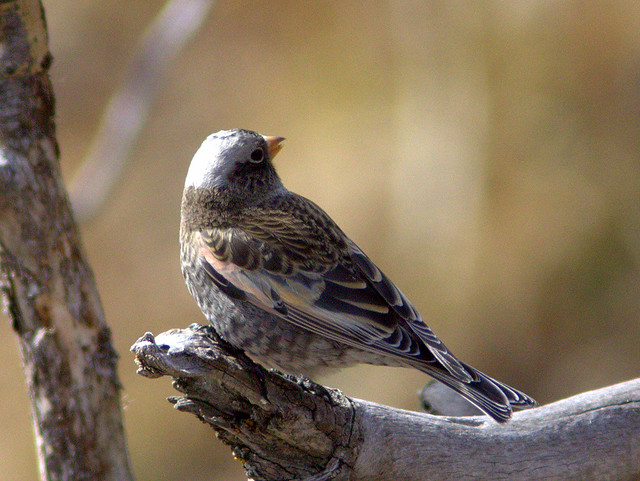
This bird that we first thought to be a Gray-crown was more brownish, but close examination of the photo reveals it to be an adult female Black Rosy-Finch. The angle of light caused reflection that made the bird look lighter than it really was.
An Abert’s Squirrel was dominating the feeder, and we had to chase it away repeatedly. The Rosies avoided the feeder when either the squirrel or a Steller’s Jay was present.
Mountain Chickadees shared the feeder…
…with Red-breasted Nuthatches…
…and the local Gray-headed race of the Dark-eyed Junco.
The next day, the forecast called for snow, but we ventured up Crest Road again. It started to rain as we checked for Pygmy Nuthatches at Doc Long Picnic Area near the base, and clouds enveloped the mountain. We turned back, deciding to bird around Albuquerque. We returned to the Crest on November 14, negotiating snow-packed areas on the road. Near the top, the moisture from the clouds had condensed to form a thick layer of hoarfrost on the trees.
Now there were flocks of up to 13 Black Rosy-Finches at the feeder. Here, two are perched on a frosty branch.
Before the banders introduced a degree of sophistication into our identification of the rosy-finches, we gave up on identifying many of the hatch-year birds, especially early in the season, as all have buffy brown tips on their contour feathers. At first we simply called them “Rosy-Finch sp.,” or “Buffies.” Now we know to take a closer look at the bases of the feathers. If they are black or very dark brown, and the bird has a whitish crown, it is a Black Rosy-Finch. Immature Gray-crowned Rosy-Finches have more cinnamon-brown feather bases. Male Blacks, even immature ones, show rather extensive pink on their underparts and wing coverts, while in females the color is very subdued. Even adult Gray-crowned Rosy-Finches show relatively little pink. This indeed is an immature (hatch year) female Black Rosy-Finch. Note the hint of pink on her shoulders and lower belly.
Our disappointment at not being able to positively identify any Gray-crowned Rosy-Finches was tempered by the appearance of the first Brown-capped Rosy-Finch of the season. Note its lack of a light crown and the more intense rosy undersides. A band from a previous season confirms that it is an adult.
Although the temperature had dropped to 22 degrees, the winds had died down, and photography conditions were much better than two days previously. Somehow, this beautiful adult black-Rosy-Finch had escaped the banding traps in previous years.
Though my fingers were about to freeze and drop off, I was able to get a nice shot of a Mountain Chickadee against a natural background…
..and a Red-breasted Nuthatch in a typical pose.
I shot this photo of a Steller’s Jay from inside the windows of the Crest House. Staff had spread the seed around to allow the finches to visit without being harassed by the jays.
Sandia Crest, just east of Albuquerque, New Mexico, is the most accessible site in the world where all three North American rosy-finch species can be seen at one time. We maintain the Sandia Crest Birding FORUM, where you will find interesting discussions on identification as well as updated sighting reports of not only the Rosies, but also such more unusual birds as Clark’s Nutcracker, Red Crossbill, Cassin’s Finch, Northern Pygmy-Owl and American Three-toed Woodpecker.
Posted by: Ken @ 4:06 pm
For Mary Lou, birding is not a sedentary pursuit. If she were a fisher-person, she would wait maybe 15 seconds for a nibble and, if none, would move on to the next fishing hole. If she were a fisher-bird, Mary Lou would be a Reddish Egret or a Tricolored Heron that seeks out prey by dashing and rushing about. I would be the Green Heron or the Great Blue, still as a statue, patiently waiting for the slightest ripple to materialize into a trophy.
I know she has my best interest at heart when she insists that all our bird walks must start out at full speed for at least the first mile. If we are out before sunrise, I don’t mind this very much. It’s too dark for photography, and I can bird by ear or test my peripheral vision as we speed by those little shadowy things fluttering in the roadside shrubs. Besides, a brisk aerobic walk is good for one’s body and spirits.
About a quarter of a mile along the unpaved road that runs into the wetland near our home, a path leads to a levee along the canal that forms the western border of our subdivision. Early in the morning, as we reported last week, Bobcats sometimes walk this path and chase after Marsh Rabbits and stalk for birds such as Common Ground Doves. (See Birds and a trio of Bobcats)
The two-track path atop the levee had not been maintained for several years, and became overgrown with tall grass and shrubs. This sharply limited the sight distance and interfered with my attempts to photograph the Bobcats. This past month a crew from the Water Management District came through and cut a 15-20 foot swath along the top of the levee. Now we can look south almost a mile to the Miami-Dade County line. We both enjoy seeing the Bobcats, so Mary Lou allows one brief detour along the path to a spot where we can check for wildlife.
A few mornings before we saw the mother Bobcat and two cubs, we checked the levee as usual, and found nothing of interest, then continued walking briskly the rest of the mile to the end of the road. By then the sky had brightened up, and on the way back I resumed my usual habit of scrutinizing the lake and surrounding wetlands. There was little of interest. Water levels are at their highest this time of year. Herons, ibises and storks are widely dispersed, not as in the late winter dry season, when fish and other aquatic creatures as well as the long-legged waders are concentrated in residual pools.
Impatient with my dawdling, Mary Lou decided to forge on ahead. I caught up with her while she was checking out the “fake hammock” (See Birding in a make-believe hammock), but it yielded no warblers– only catbirds, mockingbirds, cardinals and Blue Jays. I suggested that we check for Bobcats again, but she said she’d rather just walk back home. When I got to the top of the levee and looked down the path, I was surprised to see a Bobcat. It was dragging along a very large prey item that looked to be almost half its size. It turned and started walking away as I lifted my camera. Unfortunately, my handheld photos, taken at 300 yards, shed little light on the identity of the prey.
Click on the photo for more views. I suspect that the prey may have been a black house cat.
Cautiously moving out of the Bobcat’s view, I called Mary Lou to tell her about my find, but by then she had almost reached home. She doubted that the Bobcat would stay in place for her anyway, and was not about to walk back. Sure enough, it disappeared into the brush just after I looked back up the trail. Anticipating the possibility of obtaining another photo, I hurried up to where I last saw it.
After several minutes of quiet searching, I tried to attract the Bobcat by sucking on my knuckles to imitate the call of an injured rabbit . Actually, “knuckles” is an imprecise term– according to Webster’s New World Medical Dictionary, “Knuckle” means “the dorsal aspect of the flexed metacarpophalangeal (MCP) joint. Knuckle may be shorter and simpler to say.” I actually sucked on the next set of joints, a third of the way to my fingertips– the proximal interphalangeal (PIP) joints of the index and middle finger– they work much better.
It was like turning on a switch. The instant my squeak pierced the morning air, a House Wren burst into a loud chatter.
Almost immediately, a Blue Jay chimed in…
…followed by several mockingbirds…
…a cautious male Northern Cardinal…
…and his beautiful mate.
The alarm spread like electricity along the levee. Catbirds mewed…
…a Common Grackle chacked and crackled…
…and a Brown Thrasher let its presence known be with churrs and smacks.
An Eastern Towhee with red eyes flew up to see what was happening. Since our local towhees have yellow eyes, I knew it was a migrant from up north.
Even an Eastern Phoebe appeared out of nowhere.
By now it seemed that the birds had forgotten what had started this whole disturbance, and were feeding on each others’ excitement. Then, almost abruptly, it got quiet.
I saw why, as a Merlin sped by overhead (at least I think it was a Merlin– it happened so fast that I could only get a feeble parting shot).
On the way back home, I saw this beautiful female Painted Bunting, green on green in a treetop:
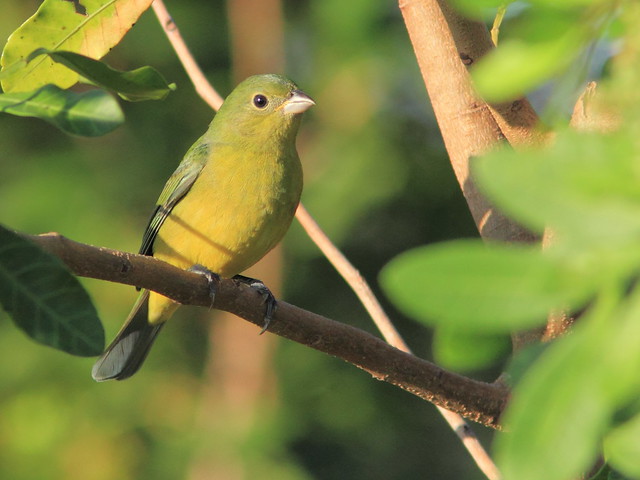
Posted by: Ken @ 3:18 pm
This morning we almost scrubbed our walk in our local wetlands birding patch. Mary Lou woke up not feeling 100% and suggested I go out without her. She knows how much I like getting out, especially during migration. Yesterday, Angel & Mariel, who track migration radar on BADBIRDZ Reloaded noted that birds were moving down into the Florida peninsula and favorable NE winds were expected to persist overnight.
Either she started recovering rapidly, or, more likely felt bad for me, as Mary Lou said she thought that the cool morning air might be good for her. Once having decided to go out, she wasted no time getting dressed, and had to wait for me. Usually we are out around 7:00 AM, about a half hour before sunrise, but this morning it was 7:25 AM before we left the house. I didn’t know it, but we were in for a big surprise this morning…
The day before, I got some pretty images of a female Prairie Warbler as she foraged for insects among the ripening berries of an exotic Brazilian Pepper::
The warbler looked so small and delicate:
I could tell from his red eyes that this Eastern Towhee had migrated in, as our locals have yellow eyes:
A nearby female towhee had yellow eyes, so it was probably a local resident:
A White-eyed Vireo stared out between the branches of a small shrub:
But back to today’s jaunt… The sun was just rising when I got this shot of a Great Egret flying overhead:
…Within minutes we reached the intersection of the gravel road and the two-track path that runs along the SW 196th Avenue Levee. As usual, we checked to see if any Bobcats might be visible. Except for the portion of the path nearest the road, the entire top of the levee had been mowed and all the trees and shrubs on either side had been pulled and moved down the slope opposite the canal, to the west. The Water District had performed this maintenance, and it opened up the sight distance in a straight line for about a mile south to the Miami-Dade County Line. This was great for photography, as intervening vegetation had hampered our earlier attempts to photograph the Bobcats, which we had found along the trail about a half dozen times since we first saw them in December, 2008. The downside was that the lack of cover made it almost impossible to hide along the way.
We walked the 50 feet or so through high grass, almost to the open path. At first we saw nothing, but suddenly we saw the shapes of at least two mammals that looked like Bobcats. At 400 or more yards, the binocular view was barely adequate to identify them as Bobcats. They were very active, running back and forth across the trail.
At first it appeared that they may have been fighting:
Then, we made out the shape of a third Bobcat, and became apparent that two were likely youngsters. here, one cub jumped up to catch an insect, probably a dragonfly:
The two cubs engaged in playful combat:
Sometimes all three disappeared into the trail-side cover, only to re-emerge into plain sight on the trail. I took advantage of this by moving out of the secluded area unto the path, where I did my best to stay far over on the side of the open swath, to help conceal my profile.
In small stages I moved nearer to the cats, getting to within about
50 yards. I took over 400 photos in the space of an hour. For a moment, two of them seemed to be engaged in a hostile stare-down:
A Northern Harrier, the first I’ve seen this fall, flew up from the trail in front of me and passed right over the Bobcats:
To my surprise, the two Bobcats starting walking towards me, an adult on the right and a nearly full-grown cub on the left:
At this point, I had to stand perfectly still in full view, in the center of the path, holding eight pounds of camera gear up to my face. Only about 50 yards away, they stared at me, maybe trying to figure out what I was:
The second cub appeared behind them, and the adult sat down and waited for it to join them:
By now, my camera felt like it weighed a ton. The second cub was noticeably smaller:
The smaller cub walked over to the left side of the trail:
It looked into the brush that bordered the canal:
Click here for a slide show of a few more of my Bobcat photos














